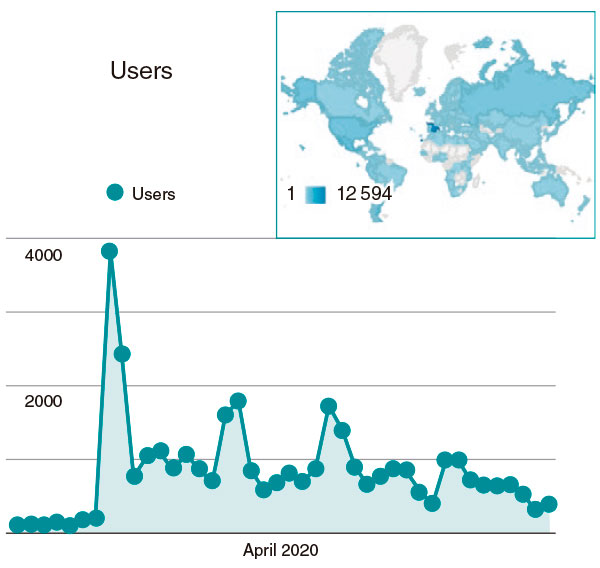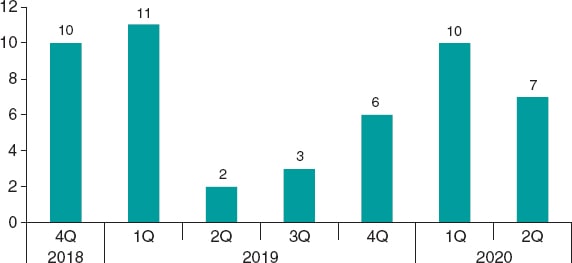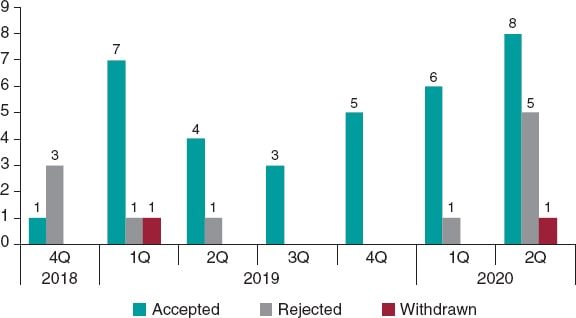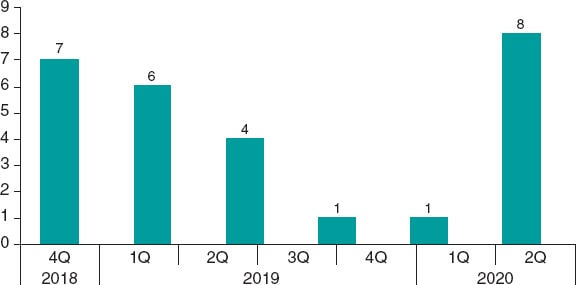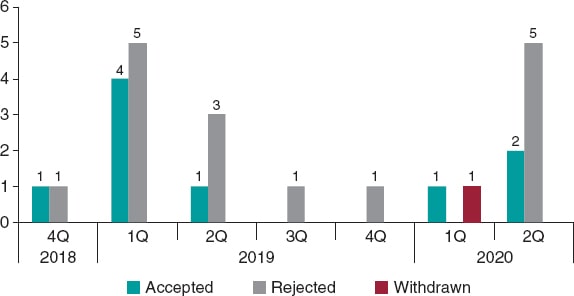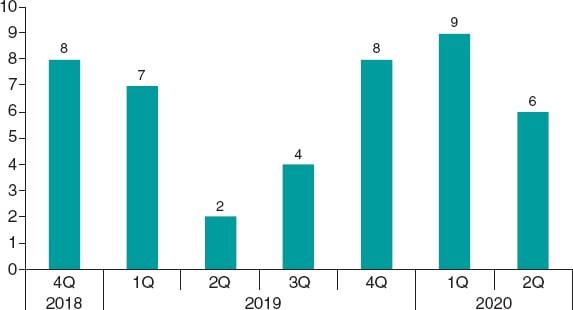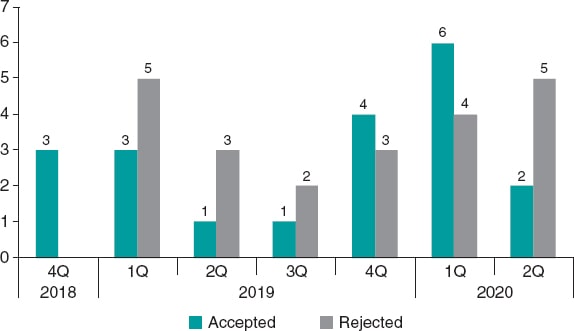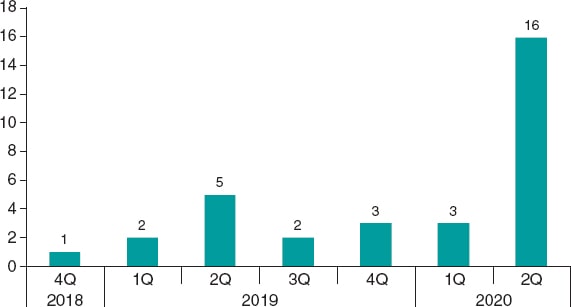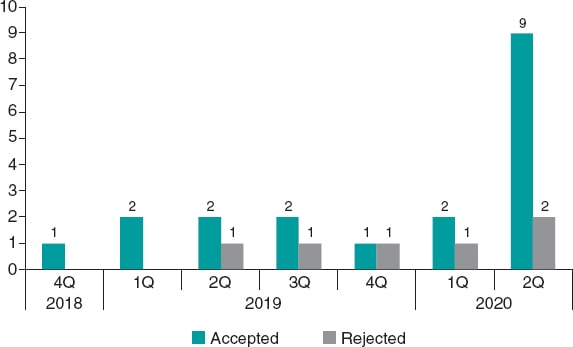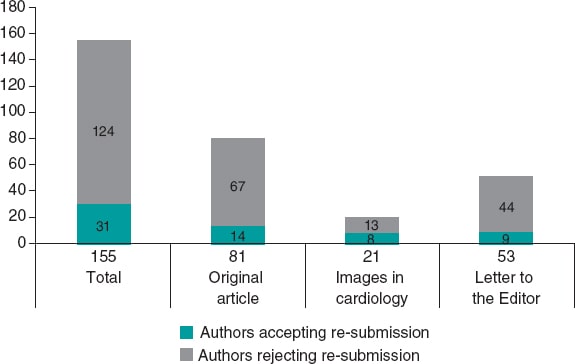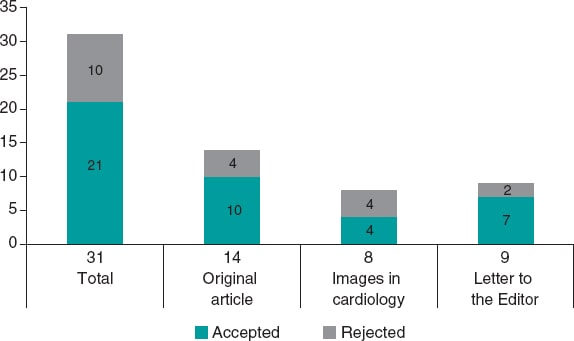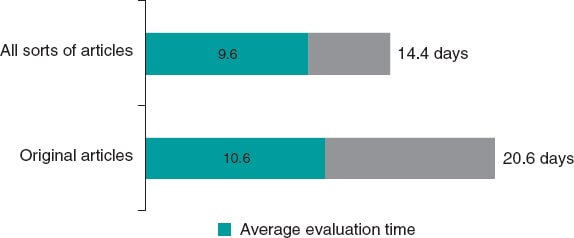Back in May 2019 at the Interventional Cardiology Association of the Spanish Society of Cardiology (ACI-SEC), we presented the first issue of REC: Interventional Cardiology (figure 1). A dream we had been dreaming for years was finally coming true. And it was coming to life the way we thought was the most suitable one, as a free of charge, open-access, bilingual (Spanish and English) publication with an optimal digital and print presentation.
Figure 1. Presentation of the journal in 2019. A: at the editorial office; from left to right: Iria del Río, María González Nogal, Helena Gómez-Lobo, Belén Juan, and Eva M. Cardenal. B: Official Congress of the Spanish Society of Cardiology (2019); from left to right: José M. de la Torre-Hernández, Raúl Moreno, Fernando Alfonso, and Juan Sanchis.
Since then, 7 issues have been published including original articles, clinical cases, letters, review articles, clinical trial reviews, editorials, debates, and news that have covered all aspects of interventional cardiology both coronary and structural.
The main protagonists of this satisfactory early adventure have been the authors who have submitted their manuscripts in different formats (original articles, cases, letters, and images) and the guests invited by the editorial team to write reviews, editorials, thematic debates, case reports, clinical case reviews or breaking news. Among them, acclaimed national and foreign experts whose names have brought excellence and high-quality to our journal.
We wish to thank the authors who have been submitting their manuscripts to our journal despite the fact that our journal has not been indexed yet or have impact metrics. They have answered our call to bring this journal to life, make it grow, and receive the recognition it truly deserves.
Special articles have been published occasionally as well such as the consensus document published on the requirements and sustainability of primary angioplasty programs for the management of infarction, which is interesting for its important implications.1
REACTION TO THE COVID-19 CRISIS
In the trajectory of REC: Interventional Cardiology from its origin until the present time we cannot overlook the tremendous health crisis triggered by the COVID-19 pandemic suffered by our country and the entire world this year. As a response to this situation, REC: Interventional Cardiology has reacted quickly and effectively. At the initiative of the board of directors of ACI-SEC, and just a few days after the SARS-CoV-2 outbreak, we were already publishing interesting articles on safety issues for the management of patients in such a complex setting.2-4 We also published articles about the impact of this crisis on the management of infarction in our country,5 a study that truly resonated with the media.6
These articles were the result of consensus papers conducted by members of the ACI-SEC with collaboration from other SEC associations and processed, in record time, by the editorial office and Permanyer Publications within incredibly short time scales. We also published a consensus document by the Mexican Interventional Cardiology Society (SOCIME).7 That is how the information needs of many interventional cardiologists in Spain and many other countries were met as the visits to our journal website from various places across the world in the days following publication showed (figure 2). We were the first ones to do so and this has had a great impact. The aforementioned article that reported on the effects that the COVID-19 pandemic had on the interventional cardiology care provided in Spain5 was quoted in medical journals such as the Journal of the American College of Cardiology, the European Heart Journal, and Circulation, among others. The work done by the authors, the editorial office, and Permanyer Publications has been outstanding, actually extraordinary, during thes difficult times.
Figure 2. Evolution of the number of users throughout April 2020. The highest peak seen was due to the articles published on COVID-19.
STATISTICS
Let’s now take a look at the journal from the statistical point of view until mid-2020. We should mention that the charts that show article reception and decision-making are not fully comparable since some articles were received at a time when publishing decisions were made at a later point in time.
Original articles
The reception of original article has gone through very different phases (figure 3). Although several articles were received during the last quarter of 2018 and the first quarter of 2019, the number of articles received at the end of the year went down significantly which was somehow disconcerting. There is no doubt that competing with indexed medical journals limits the power of attracting original articles. Despite this huge disadvantage, the reception of articles went up significantly at the beginning of 2020, thus covering the needs of upcoming issues. This situation is highly satisfactory and shows that our journal is becoming more and more popular among researchers. Still, due to its quarterly nature we will have to be even more selective in the process of accepting the papers submitted to us. However, this will increase the quality of the contents published, which is key to increase visibility and recognition. Occasionally, format change will still be an option for original articles that are not of the highest priority, but with contents that are still interesting for our journal.
Figure 3. Original articles received since the journal was launched until June 30, 2020. Q, quarter.
Forty-nine original articles were received up to June 30, 2020. Thirty-four (69%) of the decisions made during that time were in favor of publication (figure 4). The original articles published were submitted from Spain, but articles from other countries were published as well.
Figure 4. Editorial decisions made on the original articles received since the journal was launched until June 30, 2020. Q, quarter.
Clinical cases
The publication format of clinical cases includes the discussion of the case by a guest expert. We are glad to say that this section from our journal is very much appreciated by our readers.
Twenty-seven cases were received by the end of the second quarter of 2020 (figure 5). Nine cases (33% of the decisions made on articles of this kind) were accepted during the same period of time (figure 6). Since we only publish 1 clinical case per issue, we have already covered several upcoming issues. This means that in the future we’ll have to be much more restrictive when selecting new clinical cases for publication.
Figure 5. Clinical cases received since the journal was launched until June 30, 2020. Q, quarter.
Figure 6. Editorial decisions made on the clinical cases received since the journal was launched until June 30, 2020. Q, quarter.
Images in cardiology
Images are the most popular content for the authors as the number of articles received clearly shows (figure 7). On the other hand, this is obvious since this content is easier to elaborate. Also, since the use of images is essential for the practice of our medical specialty to guide diagnosis and to administer interventional treatments, we often come across interesting images. As with original articles and clinical cases, there is a list of images in the pipeline waiting for publication in upcoming issues. Because of how successful this section has actually been, we have decided to publish 3 more images in cardiology per issue starting 2021. Still, we’ll need to be more restrictive during the acceptation phase.
Figure 7. Images in cardiology received since the journal was launched until June 30, 2020. Q, quarter.
Forty-four images in cardiology were received during the second quarter of 2020 (figure 7), 20 of which (46% of the decisions made on articles of this kind) were accepted during the same period of time (figure 8).
Figure 8. Editorial decisions made on the images in cardiology received since the journal was launched until June 30, 2020. Q, quarter.
Letters to the Editor
The letters received have been very diverse, both traditional letters to the Editor and brief scientific reports. By June 30, 2020 we had already received 32 letters, a number that went up significantly at the beginning of the second quarter of 2020 (figure 9). Nineteen manuscripts of this type were accepted during this period (49% of the decisions made on articles of this kind) (figure 10).
Figure 9. Letters to the Editor received since the journal was launched until June 30, 2020. Q, quarter.
Figure 10. Editorial decisions made on the letters to the Editor received since the journal was launched until June 30, 2020. Q, quarter.
Figure 10. Editorial decisions made on the letters to the Editor received since the journal was launched until June 30, 2020. Q, quarter.
There was no predefined limit of letters per issue (a couple of them have been published in previous issues), but in light of the growing number of letters received and accepted we have established a maximum of 4 for upcoming issues.
At times, the letters have been a valid alternative to original manuscripts which, though rejected, were still considered interesting enough by the editorial team to deserve a format change into letters to the Editor.
Submission of manuscripts from Revista Española de Cardiología
This matter is of paramount importance. Revista Española de Cardiología has an excellent impact factor and, most important of all, is well known. This means it appeals to national and international researchers alike. For this reason, its percentage of manuscript rejection is fairly high. And it is the way it should be with a journal of this level, impact, and quality. Ever since we started this publishing journey and, at the suggestion of the associate editors of Revista Española de Cardiología, we have been reviewing the contents rejected by this journal and asked the authors for permission to publish them on REC: Interventional Cardiology when appropriate.
The authors have accepted this suggestion of publishing the manuscripts rejected by Revista Española de Cardiología relatively well (20%), especially if we consider the gap between both journals at the present time. Fourteen original articles were re-submitted for publication until June 2020, most of which ended up being accepted (figure 11 and figure 12). Images in cardiology was the typology most widely accepted for re-submission (38%) followed by original articles (17%) and letters to the Editor (the other 2 sections most commonly proposed for re-submission). Again, this level of re-submission should be assessed positively. However, it will grow significantly, parallel to the trajectory and visibility of the journal.
Figure 11. Articles rejected by Revista Española de Cardiología and proposed for re-submission to REC: Interventional Cardiology between January 1, 2019 and June 30, 2020.
Figure 12. Editorial decisions made on the articles submitted to REC: Interventional Cardiology from Revista Española de Cardiología between January 1, 2019 and June 30, 2020.
In conclusion, the reception of articles has been growing in all sections. Thanks to this we have already completed several upcoming issues. Nonetheless, this should make us more restrictive when accepting manuscripts. And this is not easy to handle because the articles, cases, images, and letters are all interesting to read and all have something valuable to offer. On the other hand, this measure is absolutely necessary due to the space constraints of the journal (4 issues per year) and need not avoid delaying the publication of the manuscripts too long. The indirect effect of this, is we aspire to higher levels in the contents published. Additionally, this situation allows us to give more time to guest authors to write the editorial comments associated with original articles.
REVIEWERS
Editorial times deserve a special chapter. As figure 13 shows, in general times have been appropriate compared to most medical journals with a mean first decision-making time of 14.4 days. The reviewers deserve a lot of credit because in a very short period of time (mean 9.6 days) they have reviewed the manuscripts submitted (well below the 14 days established in the deadline). The times of the editorial office from manuscript reception have been under 2 days. Still, we think the times of the editorial office handling the manuscripts before and after the evaluation phase can be shorter.
Figure 13. Average editorial times between January 1, 2019 and June 30, 2020. Means correspond to 175 evaluations of any kind (71 evaluations of original articles).
We should not only thank the evaluators for their flexibility and punctuality meeting their deadlines when submitting their reviews, but also give them credit for the quality of their comments and commitment during the entire decision-making process. The evaluators have been able to change their reviews and remarks based on the special characteristics of our journal. Table 1 shows the names of the evaluators who have collaborated with our journal until June 30, 2020.
Table 1. Revisores de REC: Interventional Cardiology que han realizado evaluaciones desde el lanzamiento de la revista hasta el 30 de junio de 2020
| Juan H. Alonso | Felipe Hernández-Hernández |
| Ignacio J. Amat | Borja Ibáñez |
| Dabit Arzamendi | Andrés Íñiguez |
| Pablo Avanzas | Luis J. Jiménez-Borreguero |
| Teresa Bastante | Santiago Jiménez-Valero |
| José A. Baz | Alfonso Jurado-Román |
| Salvatore Brugaletta | Esteban López-de-Sá |
| Ramón A. Calviño | José R. López-Mínguez |
| Xavier Carrillo | Ramón López-Palop |
| Belén Cid | Íñigo Lozano |
| Ignacio Cruz | Javier Martín-Moreiras |
| Javier Cuesta | Cesar Morís |
| José F. Díaz | Luis Nombela |
| Jaime Elízaga | Soledad Ojeda |
| Rodrigo Estévez-Loureiro | Manuel Pan |
| José A. Fernández-Díaz | Armando Pérez de Prado |
| José L. Ferreiro-Gutiérrez | Eduardo Pinar |
| Guillermo Galeote | Fernando Rivero |
| Eulogio García | Oriol Rodríguez |
| Sergio García-Blas | Rafael Romaguera |
| Tamara García-Camarero | Gerard Roura |
| Bruno García del Blanco | Juan M. Ruiz Nodar |
| Héctor M. García-García | José R. Rumoroso |
| Arturo García-Touchard | Manel Sabaté |
| Juan R. Gimeno | Ángel Sánchez-Recalde |
| Javier Goicolea | Marcelo Sanmartín |
| Joan A. Gómez-Hospital | Antonio Serra |
| Josep Gómez-Lara | Ramiro Trillo |
| Nieves Gonzalo | Beatriz Vaquerizo |
The evaluators have other commitments with other journals, some of them international and acclaimed medical journals. Still, their commitment with REC: Interventional Cardiology has been impeccable so far.
DISSEMINATION OF REC: INTERVENTIONAL CARDIOLOGY
There are different ways for all of our colleagues to access our journal including SEC and ACI-SEC official websites. REC Publications social media disseminate the contents of our journal under the hashtag #recintervcardiol. Additionally, the blog Cardiología Hoy publishes interviews with our authors on a routine basis. REC: Interventional Cardiology was officially presented at the 30th Annual ACI-SEC Meeting in 2019 and has also been present at the SEC 2019 International Symposium of Cardiovascular Disease and at various other national and international interventional cardiology meetings. We wish to thank our friends in Latin America, especially the Latin American Society of Interventional Cardiology (SOLACI), the National Association of Cardiologists of Mexico (ANCAM), and SOCIME for their warm welcome and dissemination of our journal. Readers of Revista Española de Cardiología can access our latest articles ahead of print from the SEC website and from its newsletters. Also, we have started publishing video-interviews with the authors of the articles chosen in the issues which appeared on 2020.8
ACI-SEC AWARD TO THE BEST ORIGINAL ARTICLE PUBLISHED IN 2019
This year we will be giving the very first award to the best article published on REC: Interventional Cardiology, a true recognition from SEC with an economic reward granted by ACI-SEC. This will be awarded after deliberation of a jury presided by REC: Interventional Cardiology editor-in-chief including the journal associate editors and members from the ACI-SEC board of directors. The jury will take into account the originality, scientific-methodological quality, and significance of the articles for our routine clinical practice. There will be another call for the best original article published in 2020.
A JOURNAL IMPROVING CONSTANTLY AND WITH ASPIRATIONS
Since its inception, our journal has gone through several changes. We have improved different aspects of the editorial process and responded to a working routine based on a continuous cycle of observation, critical review, and improvement.
Ours is a very young publications with much still to learn and with room for improvement. We are open to innovation and change to make the journal easier to work with for authors, readers, and evaluators.
Our next objective is to achieve indexation—a mid-term aspiration. However, we should not forget that our main objective is to achieve scientific prestige and recognition so our journal can be disseminated freely, openly, rigorously, and swiftly to the interventional cardiology scientific community.
CONFLICTS OF INTEREST
None reported.
ACKNOWLEDGEMENTS
We wish to thank all the authors and evaluators for their commitment and impeccable work. The unpleasant part of our job as the editorial team is to reject manuscripts. As authors ourselves we are fully aware of the disappointment and frustration these rejections produce. All, and I mean all manuscripts are interesting and should see the light of a publishing house. Unfortunately, the space of our journal is limited, and we are doing the best we can.
As editor-in-chief I wish to express my most sincere appreciation to my associate editors Juan Sanchis, Fernando Alfonso, and Raúl Moreno. It is my pleasure to work with them.
In his position as president of the ACI-SEC —the sponsors of the journal—Raúl Moreno is key for the economic viability of our journal. And speaking of funding, we should thank the unconditional contribution from all the companies involved in the interventional cardiology setting.
We also wish to thank the excellent work and dedication of REC Publications editorial team: Iria del Río, Eva M. Cardenal, Belén Juan, María González Nogal, and Helena Gómez-Lobo; our ICT Consultor, Pablo Avanzas, and the entire ICT team at SEC; last but not least, we wish to thank the entire staff at Permanyer Publications led by Ricard Permanyer and directed by Laura Casares as project manager. It is fair to say you would not be reading this journal without their contribution.
REFERENCES
1. Cequier A, Pérez de Prado A, Cid B, et al. Requisitos y sostenibilidad de los programas de ICP primaria en España en el IAMCEST. Documento de consenso de SEC, AEEC y SEMES. REC Interv Cardiol. 2019;2:108-119.
2. Romaguera R, Cruz-González I, Ojeda S, et al. Gestión de salas de procedimientos invasivos cardiológicos durante el brote de coronavirus COVID-19. Documento de consenso de la Asociación de Cardiología Intervencionista y la Asociación del Ritmo Cardiaco de la Sociedad Española de Cardiología. REC Interv Cardiol. 2020;2:106-111.
3. Romaguera R, Cruz-González I, Jurado-Roman A, et al. Consideraciones sobre el abordaje invasivo de la cardiopatía isquémica y estructural durante el brote de coronavirus COVID-19. Documento de consenso de la Asociación de Cardiología Intervencionista y la Asociación de Cardiopatía Isquémica y Cuidados Agudos Cardiovasculares de la Sociedad Española de Cardiología. REC Interv Cardiol. 2020;2:112-117.
4. Moreno R, Ojeda S, Romaguera R, Jiménez-Quevedo P, Cruz-González I. Implante percutáneo de válvula aórtica durante la pandemia de COVID-19. Recomendaciones de la ACI-SEC. REC Interv Cardiol. 2020. https://doi.org/10.24875/RECIC.M20000132.
5. Rodríguez-Leor O, Cid-Álvarez B, Ojeda S, et al. Impacto de la pandemia de COVID-19 sobre la actividad asistencial en cardiología intervencionista en España. REC Interv Cardiol. 2020;2:82-89.
6. RTVE.es. Coronavirus: Los cardiólogos alertan de que pacientes con infartos “no acuden a urgencias por miedo a contagiarse”. 14/04/2020. Available online: https://www.rtve.es/noticias/20200414/infartos-coronavirus-urgencias/2012022.shtml. Accessed 31 Jun 2020.
7. Piña-Reyna Y, García-Rincón A, Ortiz-Fernández PH, et al. Atención de la cardiopatía isquémica en salas de cateterismo durante la contingencia sanitaria por pandemia de COVID-19. Recomendaciones de la Sociedad de Cardiología Intervencionista de México (SOCIME). REC Interv Cardiol. 2020. https://doi.org/10.24875/RECICE.M20000126.
8. REC: Interventional Cardiology. Videos from the editor. Available online: https://www.recintervcardiol.org/es/videos-del-editor. Accessed 31 Aug 2020.



